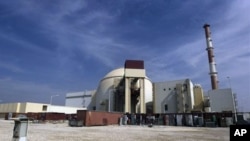Russian scientists are loading a nuclear reactor in southern Iran with enriched uranium in a process expected to make the facility fully operational within a matter of months.
Though the Bushehr facility is the first large-scale nuclear power reactor in Iran, its history goes back more than three decades - long before Iran's current Islamist government took power.
"The nuclear program in Iran goes back to the days of the Shah," said Ivan Oelrich, with the Federation of American Scientists, "and was strongly supported by the United States and the Western powers, although we did have questions even during the reign of the Shah: maybe he wanted nuclear weapons and we were a bit concerned about that."
Workers began building the Bushehr facility in 1975 under a contract signed with the German company Siemens. But four years later, the project was halted.
"At the end of the Shah's regime," said Oelrich, "he had financial problems. And when the [Islamic] revolution occurred and the mullahs took over, they canceled the program because they thought this was just sort of a way for the West to get money out of Iran."
Bushehr lay idle until 1995, when the Russians took over its construction. The nuclear power plant should have been completed in 1999. But analysts said the project was slowed by financial problems, technical glitches and contract disputes - as well as the uneasy relationship between Tehran and Moscow.
Last August, Russia transported nuclear fuel to Iran and analysts felt loading the fuel into the reactor's core was imminent. But the process was delayed several months due to a leak in the reactor's basin.
There were also problems with Bushehr's computer systems, but Iranian officials denied that they were caused by Stuxnet, a sophisticated computer virus that Western experts said seemed to target facilities in Iran.
"If it [the computer virus] was something maliciously inserted by foreigners, it would not be targeted at Bushehr, but rather at the facilities that are enriching uranium and other parts of the Iranian nuclear complex," said Greg Thielmann of the Arms Control Association, a private research firm.
Though some in the West have expressed concerns about why oil-rich Iran would need a nuclear power reactor, experts have pointed out that Russians would remain in complete control of the facility, at least the time being.
"The Russians will run the reactor for the first two years - until they can train an Iranian crew to run the reactor," said Oelrich. "There are Iranians there to learn, but the Russians right now are running the show."
The overall agreement between Moscow and Tehran runs for a decade. The Russians "will provide all of the fuel going into the reactor " said Thielmann, "and when the fuel is spent - that is when they can no longer be used to generate electricity - they will remove it again. And the removal is very important, because it is the spent fuel from which plutonium can be extracted that is a bomb-grade material that can go into weapons."
In addition, the International Atomic Energy Agency (IAEA) is supervising activities at Bushehr from beginning to end.
"They [the IAEA] will have an accounting system basically," said Thielmann, "and a monitoring system that records the amount of fuel going in, the amount of spent fuel going out and other aspects of the operation at Bushehr. We certainly seem to have enough measures in place that there's little risk of diverting the nuclear activities there to a weapons program."
Other analysts agree.
"If there is any attempt to divert material," said Oelrich, "not only will the Russians know but the IAEA would know about that. That is not a simple thing to do. Once this reactor fires up, the fuel rods will be intensely radioactive. You can't take one of these fuel rods and slip it under your shirt and walk out the door. It's a major deal handling these things and it can't be done surreptitiously."
Iranian officials have said they expect Bushehr to be fully operational - that is generating electricity - by mid-February. Analysts said the power plant will ultimately generate 1,000 megawatts of electricity. According to Oelrich, Bushehr would produce 3 percent of Iran's total electricity needs. If it were in the West, Oelrich said Bushehr would provide electricity for about one million households.
Western countries do not see the Bushehr power plant as a threat - a view recently repeated by U.S. Secretary of State Hillary Clinton. "Our problem is not with their reactor at Bushehr," she told reporters. "Our problem is with their facilities at places like Natanz and their secret facility at Qom and other places where we believe they are conducting their weapons program," she said.
Natanz is Iran's principal facility for enriching uranium.
"The Iranians say that Qom would be another facility to enrich uranium," said Thielmann. "There is also the Arak heavy water reactor . . . and that is something that could, down the road, be a source of plutonium for weapons."
Iran has consistently stated that its nuclear program is for peaceful purposes only. But Western nations have long suspected Tehran of wanting to build a nuclear weapon. Since 2006, the United Nations Security Council passed four sets of resolutions imposing sanctions on Iran, calling on Tehran to provide information about its suspected nuclear weapons program - but to no avail.
Thielmann said the problem with Iran is "the transparency of Iranian activities in the nuclear program, so that they can convince the world that they are only developing peaceful nuclear power and not developing nuclear weapons."
Iran's New Nuclear Power Plant to be Closely Monitored








